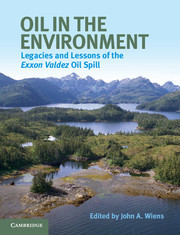Description
Oil in the Environment
Legacies and Lessons of the Exxon Valdez Oil Spill
Coordinator: Wiens John A.
Scientists directly involved in studying the Exxon Valdez spill provide a comprehensive synthesis of scientific information on long-term spill effects.
Language: English
Subject for Oil in the Environment:
Publication date: 07-2013
482 p. · 18.9x24.6 cm · Paperback
482 p. · 18.9x24.6 cm · Paperback
Description
/li>Contents
/li>Biography
/li>
What light does nearly twenty-five years of scientific study of the Exxon Valdez oil spill shed on the fate and effects of a spill? How can the results help in assessing future spills? How can ecological risks be assessed and quantified? In this, the first book on the effects of Exxon Valdez in fifteen years, scientists directly involved in studying the spill provide a comprehensive perspective on, and synthesis of, scientific information on long-term spill effects. The coverage is multidisciplinary, with chapters discussing a range of issues including effects on biota, successes and failures of post-spill studies and techniques, and areas of continued disagreement. An even-handed and critical examination of more than two decades of scientific study, this is an invaluable guide for studying future oil spills and, more broadly, for unraveling the consequences of any large environmental disruption. For access to a full bibliography of related publications, follow the resources link at www.cambridge.org/9781107027176.
List of contributors; Prologue; Acknowledgments; A bibliographic note David K. Johnson and Laura R. Rustin; List of acronyms; Part I. Introduction and Background: 1. Introduction and background John A. Wiens; 2. The phases of an oil spill and scientific studies of spill effects Paul D. Boehm, Erich R. Gundlach and David S. Page; Part II. Oil in the Environment: 3. Oil in the water column Paul D. Boehm, Jerry M. Neff and David S. Page; 4. Surveying oil on the shoreline Edward H. Owens and P. Douglas Reimer; 5. Ancient sites and emergency response: cultural resource protection Chris B. Wooley and James C. Haggarty; 6. Fate of oil on shorelines David S. Page, Paul D. Boehm, John S. Brown, Erich R. Gundlach and Jerry M. Neff; 7. Understanding subsurface contamination using conceptual and mathematical models Gary A. Pope, Kimberly D. Gordon and James R. Bragg; 8. Removal of oil from shorelines: biodegradation and bioremediation Ronald M. Atlas and James R. Bragg; Part III. Biological Effects: 9. Cytochrome P4501A (CYP1A) as a biomarker in oil spill assessments James T. Oris and Aaron P. Roberts; 10. Assessing effects and recovery from environmental accidents Keith R. Parker, John A. Wiens, Robert H. Day and Stephen M. Murphy; 11. Shoreline biota Erich R. Gundlach, David S. Page, Jerry M. Neff and Paul D. Boehm; 12. Oiling effects on pink salmon Ernest L. Brannon, Matthew A. Cronin, Al W. Maki, Larry L. Moulton and Keith R. Parker; 13. Pacific herring Walter H. Pearson, Ralph A. Elston, Karen Humphrey and Richard B. Deriso; 14. Oil and marine birds in a variable environment John A. Wiens, Robert H. Day and Stephen M. Murphy; 15. Sea otters: trying to see the forest for the trees since Exxon Valdez David L. Garshelis and Charles B. Johnson; Part IV. Assessing Oil Spill Effects and Ecological Recovery: 16. Characterizing ecological risks, significance, and recovery Mark A. Harwell, John H. Gentile and Keith R. Parker; Part V. Conclusions: 17. Science and oil spills: the broad picture John A. Wiens; Index.
John A. Wiens is Chief Scientist at PRBO Conservation Science in California, USA, and Winthrop Research Professor in the School of Plant Biology at the University of Western Australia. He has served on the faculties of Oregon State University, the University of New Mexico and Colorado State University, where he was a University Distinguished Professor. From 2002 to 2008 he was Lead Scientist with The Nature Conservancy. His work emphasizes landscape ecology, conservation and the ecology of birds.
© 2024 LAVOISIER S.A.S.

